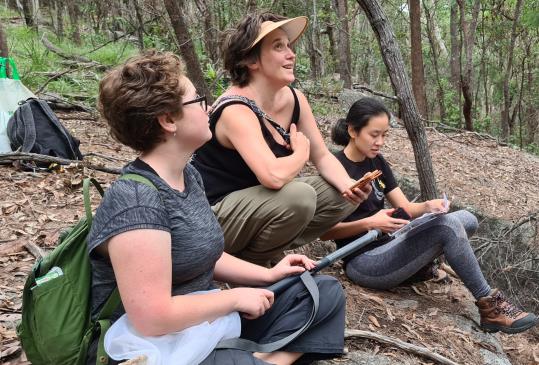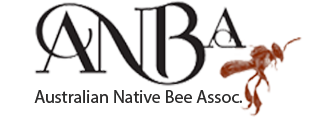Report of April meeting
We were treated to an excellent talk from our guest speaker Dr Ros Gloag from the BEE Lab, University of Sydney. If her name sounds familiar to others, it’s because she was the author of the Feature article in the last issue of the Cross-Pollinator (Issue 30 March 2022) “Olfactory eavesdropping in Aussie stingless bees”. There, you can read a biography of her and enjoy one another of her recent studies on stingless bees.

We managed to recruit Ros to speak, as she was in town with two students conducting a series of studies on stingless bees. Hopefully these students will be the next in line after Francisco. Some of you will have met Francisco Garcia BB while he was in Australia. Francis-co studied under the supervision of Ros. He was, in fact, her first PhD student. Francisco will be back in Australia for his graduation ceremony (and hopefully also to attend and present at the Australian Native Bee Conference, in June.
Ros and students are using their high-level genetic skills to investigate several questions, including the reproductive isolation of Tetragonula (why don’t the closely related T. carbonaria and T. hockingsi inter-breed to form hybrids). She is also starting work on some of the pests, including the parasite Syntretus (that some of you may have observed emerging hideously from the back end of living stingless bee adults).
Another piece of work that Ros is engaged in was the title of her talk “Queensland’s Tetragonula: How many species are there and what can they tell us about how new species arise?”
There are five Tetragonula species on Australia’s East Coast (T. carbonaria, T. davenport, T. hockingsi, T. sapiens and T. clypearis) but the precise distributions of some of these species have been difficult to con-firm due to their cryptic morphology. New evidence shows strong genetic structure in some species and suggests we need to reassess exactly how many species occur and where. Moreover, the surprisingly cryptic genetic diversity of our Aussie stingless bees suggests that they have a lot to teach us about the process of speciation itself. What general lessons can we learn about how new species arise? I will explain a new project underway, funded by The Australian Research Council, that will use stingless bees to reveal secrets about how natural selection produces new species, and the important ways in which keepers and lovers of our stingless bees can contribute to this re-search.
After the talk and questions, we dealt with some branch matters., including the next Hive exhibition
We encourage attendees to exhibit their hives at the Sydney conference. Don’t miss this chance to show your hive for a large and eager audience. Sugarbag Bees are planning for a vehicle to drive from Brisbane to Sydney to take hive exhibits. We can take a limited number of hives for other exhibitors. The hives will need to be delivered to a central point probably West End by morning of 9th June (address and date to be confirmed). Exhibits could be stocked or empty hives. We will be transporting our own stocked hives and we can also deliver living hives for others. Those who wish to exhibit hives designed for internal observation, should especially consider entering stocked hives. We are also happy to take empty hives which will of course be much simpler to transport. The hives will be opened for the weekend of the conference then closed and returned the following week. Conditions are likely to be cool, especially in Syd-ney, which should reduce stress on the hives.
Next meeting—May
Our next meeting will be held on Sunday 1st May 1pm, at Bulimba Community Centre, 1 Barramul St, Bulimba. Chris Fuller will be speaking. See page 13 of this issue for full details.
Free for members, $5 for non-members. ANBA members can attend by Zoom, a link to join will be sent by email prior to the event.
For more info on branch activities, visit our Facebook page Brisbane Branch, Australian Native Bee Association, https://www.facebook.com/bnbeec.
